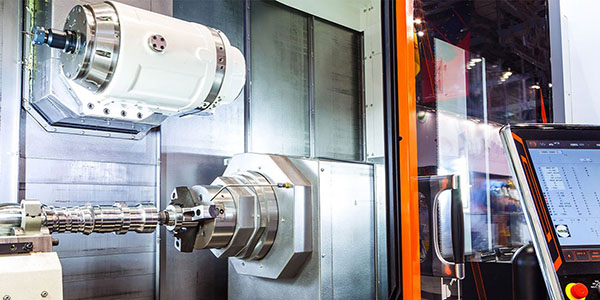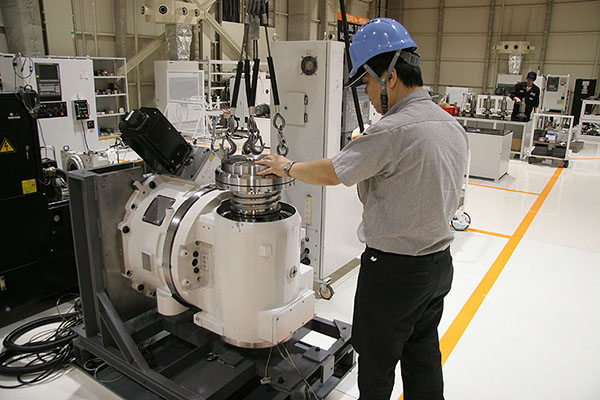The spindle is the heart of a machine tool, and when it gives out, repair and rebuild can resuscitate it for continued service and productivity. But these are delicate operations, and they must be performed according to specific process procedures using the best equipment and replacement parts. Optimal results are achieved when the professionals who originally produced the spindle are the ones to repair and rebuild it.

There are several benefits when a spindle’s original manufacturer performs the necessary repair and rebuild services beginning with unmatched expertise on the product and the repair/rebuild process best suited to the particular spindle. Immediate access to genuine, high-quality replacement components is another factor that enables the original manufacturer to provide the most cost-effective, fast and reliable solution.
Machine shops save both time and money when well-trained and experienced service engineers efficiently and accurately diagnose problems then disassemble and correctly reassemble when service is complete. Furthermore, shops gain confidence in the spindle’s performance capability when the proper equipment is used throughout the repair or rebuild process
Mazak has made its repair and rebuild program a top priority because customers depend on their machine’s spindle performance to meet their overall production and business goals.
The Spindle Repair and Rebuild Department at Mazak comprises highly trained and experienced technicians who perform every stage of the repair and rebuild process, provide complete trackable spindle documentation and conduct stringent testing of every spindle.
The certified department offers spindle repair and rebuilding services for all Mazak spindles and a wide range of units regardless of age for all types of turning centers, vertical and horizontal machining centers and Multi-Tasking machines.
One key to quick spindle repairs/rebuilds is easy access to genuine, high-quality replacement components. Mazak maintains millions in parts and unit inventory including ATCs, shifters, tables and spindles.
Likewise, Mazak adheres to stringent OEM factory specifications according to factory build procedures to ensure the highest quality standards – every time. All spindle repairs are processed in an ISO: 9001:2008 cleanroom environment and overseen by highly meticulous quality control teams.
Thorough inspection and testing of a repaired or rebuilt spindle is imperative. At Mazak, once a spindle has been returned to its original design and operating specifications, technicians conduct actual test-stand run time reliability checks. Only when a spindle passes all inspection and testing does Mazak ship it back to the customer in safe and secure packaging along with a warranty on the work done.

During a repair, Mazak disassembles, cleans, inspects and assesses a spindle’s overall condition. Technicians thoroughly evaluate all the spindle’s components for signs of wear as well as improper fit and size to determine the root cause of failure.
John Hart can request a spindle failure report to help determine if there are any potential machine issues which may have contributed to the spindle failure.
Once the cause is identified, replacement parts that meet original specifications are installed, along with new bearings, O-rings, springs and seals to complete the repair. The details of the entire repair process, including the causes of the failure, repair costs and diaries of the specific repairs made are documented, an important step in maximizing the value of the spindle.
With the current generation of spindles, tolerances are getting tighter, speeds are increasing and It Is absolutely critical to use OEM spec parts. Any change in bearing specification, ie.. preload, clearance or material can negatively impact the life and smooth operation of a spindle. A rebuilt spindle should perform the same as a brand new spindle.
When a spindle requires a complete rebuild, the process is extensive and must be completed in a clean, climate-controlled environment. A technician begins by exchanging the spindle core then precision grinding and lapping critical spindle components to ensure flatness and size, both held to within 2 microns. Spindle cartridges are balanced to within 0.5 gram for reduced vibration and improved bearing performance.
A critical step in the rebuild process occurs when technicians perform an 8-hour progressive runoff to gradually work in bearings and monitor temperature. At each stage in the rebuild process, the spindles are gauged/ tested for axial displacement, internal pressure, load settings, tool clamp force and runout to ensure the rebuilt spindle performs reliably through every cycle and to exact factory specifications.
Once we receive the rebuilt spindle back at the customer site, it is imperative to have a qualified technician reinstall the spindle. There is much more to it than simply reinstalling the part and hoping for the best.
John Hart Engineers have been trained by the manufacturer in the correct installation techniques and have the most up to date information and service bulletins relating to reinstallation of the rebuilt spindle and potential problem areas to look out for. The John Hart Service Engineer will check, where applicable lubrication, air and coolant circuits and electrical wiring for signs of damage or contamination.
Not only a machine crash will damage a spindle. Many times a fault elsewhere in the machine can over time cause a spindle to fail. This is why we recommend regular machine maintenance.
Maintenance
Regular spindle maintenance can help machine tool owners avoid or minimize the cost of a spindle repair. Several key spindle maintenance operations can significantly enhance a spindle’s performance and its longevity.
| Maintain lubricating fluids | Shops should strictly adhere to the machine tool's original manufacturer’s recommended lubrication schedules to keep fluids clean and at safe operating levels. This includes full “oil changes” for lubrication-only spindle headstocks and the regular change of air-intake filters for air/oil spindle types. |
| Check spindle runout | Periodical checks of spindle runout via a ground and calibrated spindle test bar are crucial. Original manufacturers recommend checking a spindle’s runout every six months and/or after a crash, even a minor incident. One indication that a spindle is running untrue is when workpieces suddenly trend out of tolerance. |
| Check spindle’s spring force | Spring force secures tool holders in spindles, and any drop in that force could lead to tool vibration and runout that can not only damage workpieces, but also the spindle itself. Similar to spindle runout, machine operators should regularly check a spindle’s spring force with a draw bar test. |
| Check spindle shafts on turning machines | In the event of minor crashes, the tooling or a turning machine’s turret often sustain the brunt of damage because spindle headstocks are designed, to a certain extent, to be crash resistant. Nevertheless, runout tests should be conducted after every crash as well as periodically. |
| Watch spindle vibration levels | Today’s machine tools are equipped with vibration sensing technology built into their controls. These systems will trigger an alarm in the event of unsafe spindle vibration. Increased vibration indicates worn spindle bearings, which, if ignored, can scorch spindle shafts and even cause spindles to seize during operation. Both of these scenarios are costly major repairs that could have been avoided by simply replacing worn bearings at the first sign of excessive spindle vibration. |
| Check the spindle-bearing lubrication | Many spindles are factory lubricated for life and essentially maintenance free. These are closed units to prevent any contamination. Other larger spindle headstocks, such as those on big turning machines, keep bearings lubricated with oil baths, which should be checked and the oil levels maintained. |
| Monitor cooling systems | An indicator of potential problems on high-speed spindles equipped with cooling systems is any rise in chiller system output temperature. If this occurs, a certified technician should thoroughly check the system. |
| Re-install gaskets and covers | Many of today’s machine tools have spindle areas sealed off with gaskets and/or covers. When these are removed for routine maintenance or any other reason, they should be re-installed to prevent contaminants from infiltrating the spindle, spindle motor or other components that should be sealed and protected. |
